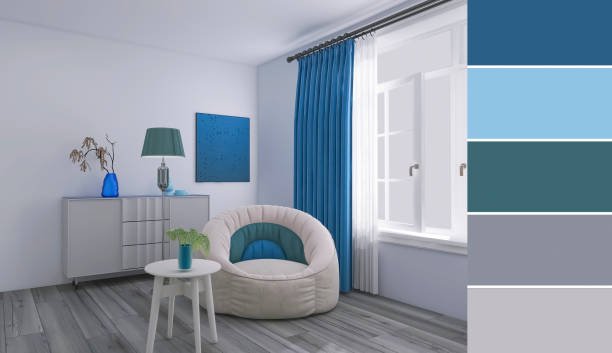Expert Tips for Choosing the Perfect Color Scheme for Your Home
Choosing the perfect color scheme for your home can transform the look and feel of your space. The right colors can enhance mood, create harmony, and even increase the value of your property. However, with endless color options available, it can be overwhelming to decide on the best palette for your home. Whether you’re updating a single room or refreshing your entire house, the process requires careful consideration. This guide will provide you with expert tips for selecting the ideal color scheme that reflects your style, complements your space, and creates the atmosphere you desire.
1. Understand Color Basics
Before diving into specific colors, it’s essential to understand some basic color principles. The color wheel, which shows the relationships between different hues, can be a helpful tool for creating harmonious combinations.
Primary, Secondary, and Tertiary Colors
- Primary colors: Red, blue, and yellow are the foundation of the color wheel. All other colors are derived from these.
- Secondary colors: Orange, green, and purple are created by mixing primary colors.
- Tertiary colors: These are the result of mixing primary and secondary colors, such as yellow-green or blue-purple.
Understanding the relationships between these colors can help you create a cohesive palette.
Warm vs. Cool Colors
- Warm colors: Reds, oranges, and yellows evoke warmth and energy. They can make a space feel cozy, intimate, and inviting.
- Cool colors: Blues, greens, and purples promote calm and relaxation. They can make a room feel more spacious and serene.
Consider whether you want to create a warm, welcoming environment or a cool, soothing one when choosing your colors.
2. Consider the Function of Each Room
Each room in your home has a different function, and the color scheme you choose should reflect the room’s purpose. For instance, the colors you select for a bedroom might differ from those for a kitchen or living room.
Living Room
As a central gathering space, the living room is often a reflection of your style and personality. Neutral tones like beige, gray, or soft pastels can create a calming, sophisticated environment. If you want to make a bold statement, you can introduce an accent wall in a deeper, contrasting color like navy blue or forest green.
Kitchen
In a kitchen, bright and cheerful colors like yellow, white, or light green can make the space feel fresh and energizing. These hues are often associated with cleanliness and can make the room appear larger and brighter. However, if you prefer a modern or dramatic look, consider darker shades like charcoal or black paired with metallic accents.
Bedroom
Your bedroom is a place of relaxation, so consider soothing, cool colors such as soft blues, muted greens, or light purples. These tones are known to promote calm and restful sleep. Neutrals like beige and soft grays are also excellent choices for creating a serene and balanced atmosphere.
Bathroom
For bathrooms, light, airy colors like pale blues, soft whites, and light grays are ideal. These shades reflect light and can make small spaces feel larger. If you want to add a touch of luxury, you could introduce metallic accents like gold or silver through fixtures and accessories.
3. Create Flow Between Rooms
When designing a color scheme for your home, it’s important to create a sense of flow between the different spaces. Using a cohesive palette throughout your home will make it feel more unified and harmonious. This doesn’t mean every room needs to be the same color, but they should complement each other.
Choose a Base Color
Select a base color that will appear in every room in some way, whether it’s through paint, furniture, or accessories. A neutral color like white, gray, or beige often works well as a foundation. You can then build upon this base by introducing complementary colors or accents.
Use Color Variations
One way to create a cohesive look while still giving each room its own personality is to use variations of the same color. For instance, you might use a pale blue in the living room, a deeper blue in the bedroom, and a muted blue-gray in the bathroom. This creates a smooth transition between spaces.
4. Take Inspiration from Your Home’s Architecture
Your home’s architectural style can offer valuable clues when selecting a color scheme. The design of your home can guide you toward colors that complement its character and enhance its features.
Traditional Homes
Traditional homes often lend themselves to classic, timeless color schemes. Consider muted tones like creams, soft grays, and warm browns. These colors complement wood accents, crown molding, and other traditional architectural details.
Modern or Minimalist Homes
For modern homes, sleek and simple color schemes work best. Neutral colors like white, black, and gray are common, with occasional bold accents. If you prefer a minimalist aesthetic, opt for monochromatic palettes with clean lines and limited contrast.
Rustic or Farmhouse Style
Rustic homes often feature natural materials like wood and stone, which pair well with earthy, warm tones. Colors like olive green, warm beige, and deep browns can highlight these natural elements and create a cozy, welcoming atmosphere.
5. Test Before You Commit
Once you’ve narrowed down your color choices, it’s crucial to test them in your space before committing. Colors can look different in various lighting conditions, and what looks perfect in a store might not have the same effect in your home.
Sample Swatches
Buy small paint samples and apply them to different areas of your walls. Observe how the color changes throughout the day as natural light shifts. Artificial lighting can also affect how a color looks at night, so make sure to view it under various lighting conditions.
Test with Furnishings
Your color scheme should complement your furniture and decor. If possible, bring fabric swatches or photos of your furniture when choosing paint colors. This will help ensure that your wall color doesn’t clash with your furnishings.
6. Consider Color Psychology
Color psychology is the study of how colors affect emotions and behavior. Different colors can evoke various feelings, so consider the mood you want to create in each room.
Blue: Calming and Serene
Blue is known for its calming and soothing properties. It’s an excellent choice for bedrooms, bathrooms, and other spaces where relaxation is the goal.
Yellow: Energetic and Uplifting
Yellow is associated with happiness and energy. It’s a great option for kitchens and dining areas, where you want to create a bright and cheerful atmosphere.
Red: Bold and Stimulating
Red is a bold, attention-grabbing color that stimulates energy and passion. It’s best used sparingly, such as in an accent wall or decor, as too much red can be overwhelming.
Green: Harmonious and Refreshing
Green is often associated with nature and represents harmony and renewal. It works well in almost any room, as it’s both calming and invigorating.
Neutral Colors: Versatile and Timeless
Neutral colors like white, gray, and beige offer a clean, timeless look that can make a room feel more spacious. These colors are versatile and can serve as a backdrop for bolder accents.
7. Don’t Be Afraid to Take Risks
While it’s essential to create a balanced and cohesive color scheme, don’t be afraid to take risks and showcase your personality through color. Accent walls, bold artwork, or vibrant furniture pieces can add visual interest and make your home feel uniquely yours.
Use Bold Accents
If you’re hesitant about using bold colors on your walls, introduce them through accents like pillows, rugs, or artwork. This allows you to experiment with color without a long-term commitment.
Mix and Match Patterns
Don’t shy away from mixing patterns and textures. For instance, a bold geometric rug paired with neutral walls and a mix of solid-colored and patterned cushions can create an eclectic and stylish look.
Conclusion
Choosing the perfect color scheme for your home can be an exciting process that allows you to express your creativity and style. By understanding color basics, considering the function of each room, and testing your choices, you can create a harmonious and inviting space that reflects your personality. Whether you prefer a bold, modern look or a calm, minimalist palette, these expert tips will guide you in making confident and informed decisions. Remember, the right color scheme can transform not only your home’s appearance but also how you feel within it.






